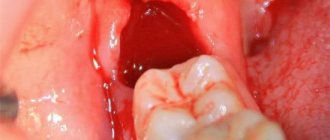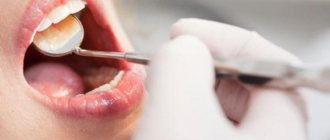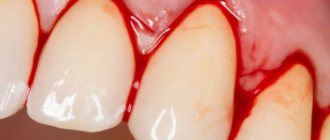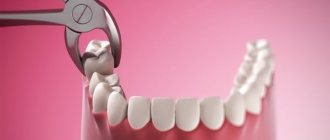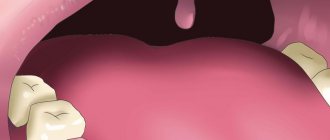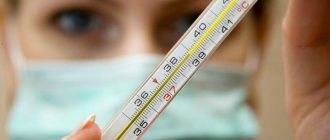From this article you will learn:
- How much can you not eat after tooth extraction?
- what antibiotics and rinses to use,
- How long after you can smoke after tooth extraction?
The article was written by a dental surgeon with more than 19 years of experience.
If you have just had a tooth removed, it is very important to know what to do after tooth extraction. This will prevent complications that often arise as a result of patient behavior errors (inflammation of the socket, development of bleeding or swelling of the soft tissues of the face). And I will try to summarize my experience accumulated over many years of work as a dental surgeon in this article.
The most common mistake is that patients rinse their mouth too much, which leads to the blood clot falling out of the socket. As a result, we will get inflammation of the socket of the extracted tooth - alveolitis of the socket. Either the patient took aspirin before or after tooth extraction (without thinking that aspirin thins the blood) and, accordingly, in this case we will have a high risk of bleeding and hematoma formation.
Tooth extraction: photo
Also at the end of the article you will be able to see what the sockets of extracted teeth should normally look like (at different times after extraction). This will help you decide if you need to re-examine with your dental surgeon.
What to do with a gauze swab -
A tooth was removed today: what to do after removal with a gauze swab on the socket... A swab soaked in blood is an excellent breeding ground for infection. And the longer you keep it in the mouth, the greater the risk of developing inflammation in the socket of the extracted tooth. If you still have a gauze swab on your socket, you need to remove it urgently. It is advisable to do this without jerking and not strictly vertically, but sideways (so as not to pull out the blood clot from the hole along with the tampon).
An exception may be a situation where the hole is still being touched up - in this case, the gauze swab can be held for a little longer. But it’s best to spit out this old gauze swab soaked in saliva and blood, make a new one from a sterile bandage, and place it on top of the hole (biting firmly).
Important: saliva at first may normally turn pink due to the secretion of ichor (this should not be confused with bleeding). At the same time, it is not clear why many patients stop swallowing saliva and accumulate it in the oral cavity. There is absolutely no need to do the latter; saliva can be swallowed as usual.
Gum healing process
The speed of gum healing depends on several factors:
- individual characteristics of the patient’s immunity;
- the success of the operation;
- location of the extracted tooth.
If the tooth is in a hard-to-reach place, has crooked roots, or its crown has been significantly damaged, then the removal procedure becomes more complicated. During manipulation, the tooth may begin to crumble, leaving fragments in the gum. In this case, it is necessary to cut the gum tissue, detach it from the bone, remove the tooth in parts, and use a drill. These traumatic procedures prolong the period of gum healing after surgery.
Slight swelling of the gums is considered normal. The temperature may rise slightly (due to an immune reaction). The swelling usually subsides within three days.
Noticeable swelling of the gum is also observed after cutting it. This swelling goes away in about one week.
How soon can you eat after tooth extraction?
Most often, patients are interested in when they can eat after tooth extraction and what food is best to eat. You can safely eat after 2 hours, but on the same side (where the tooth was removed) it is not advisable to chew anything dense or hard in the first days after extraction. This is necessary in order not to injure the fresh blood clot in the socket of the extracted tooth.
You can drink water immediately after tooth extraction. As for food, if you still can’t wait 2 hours, then you can absolutely safely drink a glass of kefir or eat yogurt right away. In general, there is no ban on any specific foods; it is only necessary that the prepared food be soft in the first days (for example, if there is meat, then it must be cured).
Apply cold to prevent swelling -
What to do after tooth extraction to prevent the development of swelling... As soon as you come home, your first actions are to take ice or a piece of frozen meat from the freezer, wrap it in a towel and apply it to your cheek in the projection of the extracted tooth (24stoma.ru). This is necessary to avoid or reduce possible swelling of the soft tissues of the face that may develop (especially if the removal was difficult).
It is necessary to hold the ice 3-4 times for 5 minutes, with an interval of 5-10 minutes between each approach. It makes sense to keep ice only in the first hours after removal, then it is useless. But heating and applying heat is strictly forbidden, because... In this case, suppuration is guaranteed.
Important: if you want to avoid the development of swelling of the soft tissues of the face as much as possible, then in addition to using cold, be sure to take antihistamines (anti-allergic) medications in the first 2-3 days after removal. This group of drugs also has a good anti-edematous effect. Suprastin is especially suitable: 1 tablet per day before bed (for 2-3 days).
What you need to know about bleeding?
Excessive bleeding after tooth extraction is usually a consequence of certain health problems. It can be:
- poor blood clotting;
- damage to nearby vessels or bones;
- inflammation in surrounding tissues;
- extensive surgical field.
In addition, this phenomenon can be caused by unqualified actions of the dentist who pulled out the tooth, or violation of his instructions by the patient himself.
In a normal situation, a blood clot that stops bleeding will form within half an hour. This even applies to surgical interventions that involve cutting the gums. In general, heavy bleeding is not a big deal, since there are many blood vessels around the tooth. However, it should stop within 30 minutes. A longer period is needed if the patient suffers from the following diseases:
- alcoholism (alcohol slows down regeneration processes);
- vascular diseases, including acute leukemia;
- hypertension;
- anemic conditions.
It is worth considering that in this case we are talking about primary bleeding, that is, when blood flows after removal. If it stops, but after some time the bleeding resumes, it is called secondary.
Many people mistake ordinary ichor for blood. To notice the difference, you should study the nature of the discharge. The color of ichor is whitish or yellowish, and that of blood is scarlet. In addition, blood is viscous. The discharge of ichor within a few hours is considered normal.
Consult a doctor URGENTLY
- severe swelling of the gums;
- spread of pain to part of the head or face;
- a large volume of secreted blood that needs to be spit out;
- feeling of general weakness;
- increasing dizziness;
- rapid increase in body temperature.
Is it possible to drink alcohol after tooth extraction?
Due to the stress they have experienced, many patients separately ask whether it is possible to drink alcohol after tooth extraction. In general, drinking alcohol is contraindicated during the first 24 hours after removal, but if the doctor has prescribed antibiotics, then alcohol should not be taken during the entire course of antibiotic therapy (i.e. 5-7 days).
If antibiotics were not prescribed, then, of course, a small amount of weak alcohol is unlikely to cause any consequences. But large doses can lead to the fact that the hole may begin to bleed again, or a hematoma may appear.
What not to do?
The postoperative period after tooth extraction is 5-7 days. At this time, you need to be attentive to your health, measure your temperature, and monitor for bleeding. If the pain persists for more than 2 days or intensifies (or becomes throbbing), you should contact your dentist.
Over time, healthy tissue forms at the site of the blood clot, but this can be disrupted if the area is not properly cared for. After tooth extraction surgery it is not recommended to:
- Taking anticoagulants because they thin the blood.
- Bathing in a hot bath, visiting a bathhouse and sauna. Sudden changes in temperature can be harmful, as they cause spasms or dilate the lumen of blood vessels. As a result, the pain will intensify and bleeding may resume.
- Rinsing the mouth.
- Drinking alcoholic beverages.
- Smoking.
- Spitting, as this may dislodge the blood clot.
- Treatment of other teeth, including caries, earlier than a week after extraction. As a result, infection can occur, since carious teeth contain many bacteria.
- Strenuous physical activity, especially heavy lifting and bending. This is one of the reasons for increased blood pressure, which serves as a provoking factor for the opening of bleeding.
- Chewing food on the “sick” side of the dentition.
- Active facial expressions. If there are sutures in the oral cavity, they can break and even come apart.
What not to do after tooth extraction -
What absolutely cannot be done after tooth extraction...
- for the first 1-2 days, you should not take a hot bath (a warm shower is fine), or sleep lying on the side of the extracted tooth - all this will contribute to the appearance of swelling,
- visit the pool or sauna during the week,
- engage in heavy labor (to avoid bleeding),
- picking at the wound with foreign objects, tongue,
- open your mouth wide and make active facial movements, because if stitches were placed, they may come apart,
- do not take aspirin as a pain reliever (it thins the blood and thereby promotes bleeding and bruising),
- You should not rinse your mouth intensively in the first 2-3 days, because intensive rinsing can lead to a blood clot falling out of the socket (this will certainly lead to its inflammation).
Painkillers –
If the extraction was simple, you may not need pain relief after tooth extraction. But if you want to completely prevent the appearance of pain, then it is better to take a strong tablet analgesic even before the anesthesia wears off (which one is better to choose - see the link, but remember that after removal you cannot take aspirin).
Sometimes the pain is very severe. As a rule, this happens if the removal was performed by a doctor in a very traumatic way or if inactive bone fragments were left behind. The pain is most severe when the doctor used a drill to drill out the bone, and water cooling was not used (this leads to necrosis of bone tissue as a result of overheating).
Important: numerous studies show that the severity of pain after tooth extraction is reduced by an average of 30-50% if the doctor places sutures on the socket of the extracted tooth. In addition, bringing the edges of the mucous membrane together by applying sutures helps protect the blood clot from loss and injury, sharply reduces the risk of developing inflammation of the socket, and almost completely eliminates the occurrence of bleeding.
After a simple simple extraction, most dental surgeons very rarely use sutures. I can recommend for the future - always before removal, ask your surgeon to put 1-2 stitches on you, even if the removal is simple, and even if you have to pay an extra 300-400 rubles for it. As a rule, sutures do not have to be removed (they dissolve on their own), but they will reduce pain and reduce the risk of complications.
Antiseptic rinses/baths –
Remember that you should not rinse your mouth vigorously during the first few days after removal, because... you can easily rinse the blood clot out of the socket. Food will constantly accumulate in a hole without a clot and rot there, causing inflammation and pain. It is better to replace rinses with baths (pour an antiseptic solution into your mouth, hold it and spit it out, or lightly “squelch” it).
When are antiseptic baths necessary?
- if the tooth was removed due to inflammation,
- an incision was made on the gum to expose the gumboil,
- if you have teeth with untreated caries or dental plaque, infection in which can lead to suppuration of a blood clot.
Antiseptic baths are best done with an aqueous solution of Chlorhexidine 0.05-0.12%. This drug has a pronounced antiseptic effect and is slightly bitter in taste. Baths should be done 3 times a day (keep the solution in your mouth for about 1 minute each time).
Possible complications
Signs of alarm should be considered an enlargement of the cheek, further spread of swelling, a persistent increase in temperature, increased pain, nausea, and weakness. If the healing process is disrupted, the following complications may occur:
- Cyst formation. It is a fibrous neoplasm filled with fluid.
- Flux. Formed after infection penetrates into the socket and then into the periosteum. The resulting inflammation is characterized by severe swelling of the cheek on the side of the diseased gum. There is severe pain and redness of the gums. The formation of flux requires immediate medical attention. Therefore, it is necessary to carefully protect the site of the extracted tooth from possible infection.
- Alveolitis. This is a complication that occurs during the inflammatory process of the hole in the jaw bone. The infection occurs due to a violation of the integrity of the protective blood clot. The onset of the disease is characterized by inflammation of the outer layers of the socket, spreading into the deep layers of the bone. Alveolitis is accompanied by aching pain during eating, swelling and redness of the gums. There is a putrid odor from the mouth. The patient feels chills, headache, and fever. The occurrence of the disease most often occurs during the extraction of molars located on the lower jaw. It is necessary to obtain medical attention in a timely manner to avoid the spread of infection to other organs. One of the dangerous complications of the disease is osteomyelitis.
Removing wisdom teeth is a more complex procedure, so gum inflammation often occurs after surgery. At the same time, discoloration or swelling of the gums should not cause concern to the patient. Often after surgery there are difficulties opening and closing the mouth. This is a consequence of surgery. To get to a hard-to-reach place, the doctor asks the patient to open his mouth as wide as possible. The pressure exerted on the tissues leads to their swelling. On the 3rd day, the discomfort usually goes away completely. The appearance of purulent contents in the hole, increased temperature, acute pain, heavy bleeding - all these signs require immediate contact with the dentist.
Antibiotics after tooth extraction –
Antibiotics after tooth extraction should be prescribed by a dental surgeon and not taken independently. An antibiotic for tooth extraction is always prescribed in situations where -
- the tooth was removed due to inflammation,
- it was difficult to remove
- there is a risk of complications.
Amoxiclav after tooth extraction is one of the most effective and popular drugs among dental surgeons, because it has affinity for bone tissue. Adults need Amoxiclav 625 mg (each tablet contains amoxicillin 500 mg and clavulanic acid 125 mg). The drug is taken 2 times a day for 5 to 7 days. But we DO NOT RECOMMEND taking this drug, because... immediately in 10-25% of patients - it causes antibiotic-associated diarrhea. Follow the link above to read a review article on the use of antibiotics in dentistry.
Reduce the risk of developing diarrhea when taking Amoxiclav or Augmentin - if you combine it with taking Metronidazole (Trichopol). This combination is not only safer in terms of diarrhea, but also significantly enhances the antibacterial effect. The antibiotic Metronidazole is especially effective against anaerobic bacteria and protozoa, which are especially numerous in chronic purulent inflammation (for example, in the area of the roots of teeth), while Amoxiclav and Augmentin do not have a clinically significant effect on protozoa.
But the risk of diarrhea will be lowest when using fluoroquinolone antibiotics. Among the antibiotics of this group, we especially highlight the combination drugs “Tsiprolet-A” or “Tsifran-ST”, which in addition to 500 mg of ciprofloxacin also contain 600 mg of tinidazole. Fluoroquinolones themselves cause diarrhea in only 1-2% of cases, but the above drugs also contain tinidazole (an analogue of metronidazole). Tinidazole also has antiprotozoal activity, i.e. it will be effective against anaerobic microorganisms, including Clostridium difficile and Clostridium perfringens, which are responsible for the development of diarrhea while taking antibiotics,
Important: because These antibiotics are not cheap - as an alternative, we will also indicate such a drug as the usual “Tsiprolet”, which contains only ciprofloxacin (without tinidazole). This antibiotic costs only 90 rubles per pack, but it is slightly less effective for purulent inflammation than the antibiotics Tsiprolet-A or Tsifran-ST.
Another antibiotic that everyone knows about is Lincomycin 0.25 (taken 2 capsules 3 times a day, usually 5 days). This is an inexpensive, moderately effective drug, but it kills all life in the intestines due to poor bioavailability (only 30% of the drug is absorbed from the intestines if taken on an empty stomach, and only 6% when taken with food). Therefore, it may turn out that, having bought a cheap antibiotic, you will then have to “expensively” restore the intestinal microflora.
How to reduce the risk of diarrhea after taking antibiotics -
Of course, parallel intake of probiotics (i.e., drugs that contain bacteria beneficial to our intestines) can help you with this. There are a large number of probiotics, but the best of them are Linex and Bifiform. Keep in mind that it is better to choose multicomponent preparations that contain several types of beneficial bacteria. Probiotics may contain lactobacilli, bifidobacteria, enterococci, and their combinations.
Probiotic Bifiform (30 capsules) –
If there is blood coming from the hole -
There are several effective methods to stop bleeding.
Most often, the wound bleeds in people who have high blood pressure (hypertension). However, a rise in blood pressure can be triggered in completely healthy people due to psychological stress. The first thing to do is to apply a tightly twisted swab of sterile bandage to the wound, and then immediately measure the pressure. And if it is elevated, take the appropriate drug. For more information on how to stop bleeding, read the article: → “How to stop bleeding from a tooth socket at home”
If you have high blood pressure -
If you regularly measure your blood pressure, if it is higher than normal, take the appropriate medication. Otherwise, there is a very high risk of bleeding or hematoma formation. The first can lead to weakness and dizziness, and the formation of a hematoma is fraught with its suppuration and the need to open it.
If you have diabetes -
If you have a device for determining blood sugar, it is advisable to immediately measure your sugar. The stress of removal contributes to the release of adrenaline, the concentration of which largely determines blood sugar levels. This will help you prevent feeling unwell.
Removing sutures after removal –
After tooth extraction, the sutures are usually removed no later than 7-8 days. However, removal of sutures may not be necessary if, for example, catgut is used as a suture material. This material dissolves on its own within 10 days. When you see that the seams are very loose, you can simply remove them with clean fingers.
Treatment of teeth after extraction –
It is advisable to continue treatment after tooth extraction no earlier than 7 days later. If the removal was difficult, then sometimes it may take up to 14 days. This is due to the fact that carious teeth contain a lot of pathogenic infection, which, when drilling a tooth, can easily get into a blood clot and lead to suppuration.
Features of the gum restoration process
Sometimes patients wonder if there are any differences in the recovery process, depending on what kind of surgery was performed on the patient. The answer is yes, there are such features. Let's consider three main variants of the situation.
Standard tooth extraction
When a person is healthy, the removal went well, and the tooth itself was not classified as complex, the restoration process begins immediately.
The recovery process takes longer if the tooth was large and a wide wound appears in its place. In this case, the dentist will apply stitches. They last on fabric for 7-8 days, sometimes less or more. Throughout this time, you may feel pain or signs of an inflammatory process.
After 3-4 weeks, most patients experience complete restoration of the gums. The pain goes away, swelling is relieved, and the periodontium heals. Bone tissue begins to form, and from the outside the removal site already looks quite healthy.
Removal before prosthetics
Sometimes tooth extraction may be necessary before prosthetics can be performed. The dentist makes this decision when restoration or the use of special orthopedic structures is impossible.
The removal is done with a view to installing an implant or bridge, which the old tooth will only interfere with. A periosteum augmentation process may also be required. It is more common when teeth are removed from the upper jaw, when there is simply not enough tissue for normal implant placement.
The augmentation procedure significantly increases the recovery time. It is difficult to predict the timing here; you need the attending physician to carefully monitor your condition.
Wisdom tooth removal
The most complex and difficult to predict removal process is wisdom tooth extraction. It is necessary if the tooth grows at the wrong angle, interferes with its neighbors in the dentition, and can cause irritation and other problems.
With this type of operation, the gums can be severely damaged. There are several reasons:
- A large number of roots. They can cause significant damage to your gums during the removal process. Sometimes resection may be required.
- The wisdom tooth is often hidden behind the gum. In this case, an incision will need to be made and exposed before removal can be carried out.
- Often the tooth is located at an angle. He can strongly push against his neighbors. At the same time, the dentist decides how to reduce the pressure and not damage other teeth.
After removal, the gum is not in the best condition and may require stitches. This means that the hole will take longer to heal.
What should a socket of an extracted tooth normally look like?
As you will see below, the blood clot after tooth extraction first has an intense burgundy color. Gradually, the surface of the clot becomes whitish/yellowish (this is normal, because fibrin effusion occurs). Normally, the blood clot should be dense the next day. If the clot becomes loose, this means it has disintegrated, and you should familiarize yourself with the symptoms of inflammation of the socket in order to consult a doctor in time.
What does the gum look like after tooth extraction (normal) –
Oral care after tooth extraction –
The oral cavity requires careful care after tooth extraction. Teeth should be brushed as usual, including the group of teeth in the area of the extracted tooth. The latter are simply cleaned more carefully so as not to injure the blood clot. You also need to carefully rinse your mouth from foam so as not to rinse the clot out of the hole.
You also need to care for your gums after tooth extraction (antiseptic baths, which we described above, are sufficient for this). But the lack of proper hygiene will cause the accumulation of soft microbial plaque, which is fraught with suppuration of the hole and the development of alveolitis. We hope that the article on the topic: Tooth pulled out, what to do - was useful to you!
Sources:
1. Dental education of the author of the article, 2. Based on personal experience as a dental surgeon, 3. National Library of Medicine (USA), 4. “Outpatient surgical dentistry” (Bezrukov V.), 5. “Propaedeutics of surgical dentistry” (Soloviev M.).
